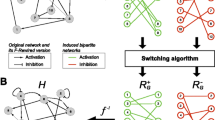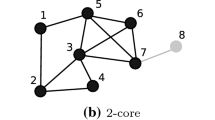Abstract
In the course of understanding biological regulatory networks (BRN), scientists usually start by studying small BRNs that they believe to be of particular importance to represent a biological function, and then, embed them in the whole network. Such a reduction can lead to neglect relevant regulations and to study a network whose properties can be very different from the properties of this network viewed as a part of the whole. In this paper we study, from a logical point of view, the preservation of properties inherited from small BRNs. The signature of BRN, constituted by a graph, is one of the distinctive features on which embeddings can be defined which leads us to give a first condition on the subgraphs ensuring the preservation of properties of the embedded graphs.
This work is performed within the European project GENNETEC (GENetic NeTworks: Emergence and Complexity) STREP 34952.
Preview
Unable to display preview. Download preview PDF.
Similar content being viewed by others
References
Aiguier, M., Le Gall, P., Mabrouki, M.: A formal denotation of complex systems: how to use algebraic refinement to deal with complexity of systems, Tech. report (2008), http://www.epigenomique.genopole.fr/~aiguier
Bernot, G., Comet, J.-P., Richard, A., Guespin, J.: Application of formal methods to biological regulatory networks: Extending Thomas’ asynchronous logical approach with temporal logic. Journal of Theoretical Biology 229(3), 339–347 (2004)
de Jong, H.: Modeling and simulation of genetic regulatory systems: a literature review. J. Comput. Biol. 9(1), 67–103 (2002)
de Jong, H., Geiselmann, J., Hernandez, C., Page, M.: Genetic network analyzer: qualitative simulation of genetic regulatory networks. Bioinformatics 19(3), 336–344 (2003)
de Jong, H., Gouzé, J.-L., Hernandez, C., Page, M., Sari, T., Geiselmann, J.: Qualitative simulation of genetic regulatory networks using piecewise-linear models. Bulletin of Mathematical Biology 66(2), 301–340 (2004)
Emerson, E.A.: Temporal and modal logic. In: Handbook of theoretical computer science formal models and semantics, vol. b, pp. 995–1072. MIT Press, Cambridge (1990)
Glass, L., Kauffman, S.A.: The logical analysis of continuous non-linear biochemical control networks. J. Theor. Biol. 39, 103–129 (1973)
Goguen, J.A., Burstall, R.-M.: Institutions: Abstract model theory for specification and programming. Journal of the ACM 39(1), 95–146 (1992)
Mateus, D., Gallois, J.-P., Comet, J.-P., Le Gall, P.: Symbolic modeling of genetic regulatory networks. Journal of Bioinformatics and Computational Biology (2007)
De Nicola, R., Vaandrager, F.: Three logics for branching bisimulation. J. ACM 42(2), 458–487 (1995)
Thieffry, D., Thomas, R.: Dynamical behaviour of biological regulatory networks - ii. immunity control in bacteriophage lambda. Bull. Math. Biol. 57(2), 277–297 (1995)
Thomas, R.: Logical analysis of systems comprising feedback loops. J. Theor. Biol. 73(4), 631–656 (1978)
Thomas, R., d’Ari, R.: Biological feedback. CRC Press, Boca Raton (1990)
van Glabbeck, R., Weijland, W.P.: Refinement in branching time semantics. In: Proc. IFIP Conference, pp. 613–618 (1989)
Wehrheim, H.: Inheritance of temporal logic properties. In: Najm, E., Nestmann, U., Stevens, P. (eds.) FMOODS 2003. LNCS, vol. 2884, pp. 79–93. Springer, Heidelberg (2003)
Author information
Authors and Affiliations
Editor information
Rights and permissions
Copyright information
© 2008 Springer-Verlag Berlin Heidelberg
About this paper
Cite this paper
Mabrouki, M., Aiguier, M., Comet, JP., Le Gall, P. (2008). Property Preservation along Embedding of Biological Regulatory Networks. In: Horimoto, K., Regensburger, G., Rosenkranz, M., Yoshida, H. (eds) Algebraic Biology. AB 2008. Lecture Notes in Computer Science, vol 5147. Springer, Berlin, Heidelberg. https://doi.org/10.1007/978-3-540-85101-1_10
Download citation
DOI: https://doi.org/10.1007/978-3-540-85101-1_10
Publisher Name: Springer, Berlin, Heidelberg
Print ISBN: 978-3-540-85100-4
Online ISBN: 978-3-540-85101-1
eBook Packages: Computer ScienceComputer Science (R0)




